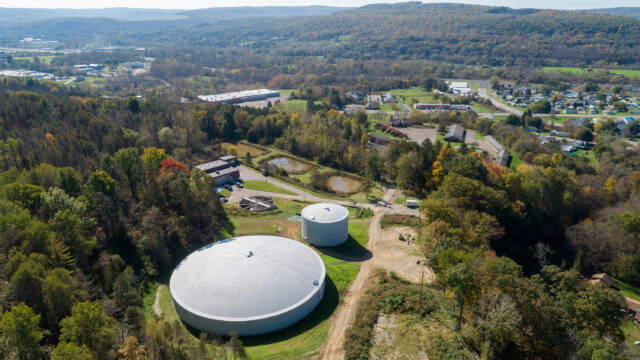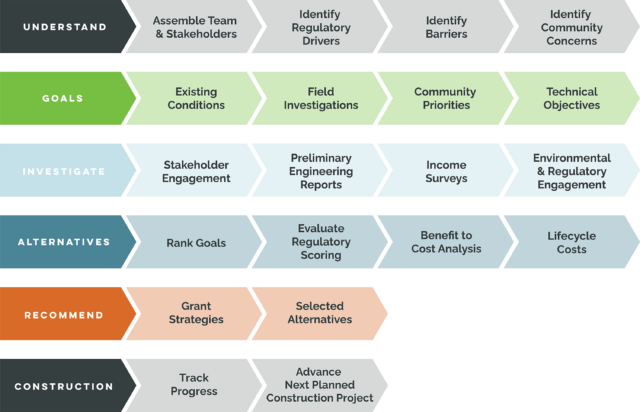Integrated Engineering and Planning: Navigating Complex Capital Projects

Achieving sustainable development in today’s rapidly changing world requires new strategies that go beyond traditional methodologies. An integrated engineering and planning framework is not just a model but a transformative force for sustainable development. It highlights the power of cross-disciplinary collaboration, where diverse expertise converges to create technically sound solutions that resonate with the communities they serve.
This methodology represents a paradigm shift away from the traditional approach of separate engineering and planning processes, where consultants are activated to solve a challenge and decisions are primarily made by analyzing cost-effectiveness and regulatory compliance. The integrated engineering and planning approach emphasizes a holistic method for fostering sustainable communities through strategic planning, innovative engineering solutions, and robust community engagement. The goal of this approach is to foster more resilient and thriving communities.
The following offers a closer look at the process and outcomes of this approach, highlighting recent experiences and successes in two New York municipalities, the City of Hornell and the Village of Massena.

Process
The integrated engineering and planning approach focuses on developing projects that are aligned with community needs and capable of securing funding, which ensures that the project mirrors the municipality’s collective vision and aspirations. This cross-disciplinary approach allows for comprehensive scoping, planning, evaluation, and advancement to understand community needs, regulatory requirements, and funding opportunities to benefit the community.
A key element of this approach is stakeholder engagement and collaboration throughout the technical planning process. Talking with both municipal leadership and municipal infrastructure operators ensures that community priorities are understood, project goals are clearly defined, and the performance of alternatives is thoroughly evaluated. When leaders from different community sectors are involved in dialogue and decision-making, it fosters a more comprehensive understanding of the community’s needs and aspirations, leading to more holistic and widely accepted solutions. Community priorities are not just heard but understood, project goals are not just set but defined, and alternatives are not just considered but thoroughly evaluated.

Outcomes
The success stories from the City of Hornell and the Village of Massena are evidence of the efficacy of the integrated engineering and planning approach.
In Hornell, a decades-long collaboration has led to significant infrastructure improvements, enhancing residents’ quality of life and facilitating economic growth. This partnership includes annual planning sessions between community members and an interdisciplinary planning and engineering team, yielding prioritized projects and a long-term vision. From these planning sessions, significant improvements across various infrastructure projects have been achieved, including water treatment plant enhancements, water distribution system upgrades, and comprehensive evaluations and upgrades to the water pollution control plant. These projects have improved the residents’ quality of life, protected vital waterways, and facilitated economic growth.
The Village of Massena is a current and ongoing example of this approach in action. Planning and coordination with public, private, municipal, and community members to advance projects with complex ownership and rights is the main priority. The proposed projects mirror the integrated and community-centric approach to engage a broader set of involved and interested agencies. Through project planning, grant writing, and engineering services, LaBella has worked closely with Village officials and technical operators to align actions with community needs and economic opportunities. This process has already seen the successful administration of grants totaling over $11.7 million for critical infrastructure projects.
The integrated engineering and planning approach exemplifies how comprehensive community engagement, strategic planning, and innovative engineering can foster resilient and thriving communities. The experiences of Hornell and Massena reinforce the transformative potential of an integrated approach and emphasize that success in infrastructure projects extends beyond project completion.

About the Author
Jennifer Vaughn, EITCivil Engineer/Grant Specialist
With 14 years of experience as a civil/environmental engineer and a grant specialist, Jennifer supports municipal clients in prioritizing projects, securing grant funds, completing studies, and executing community improvement projects. She has served over 50 municipalities, helping them to secure more than $75 million in grant funding from state and federal agencies. Additionally, Jennifer has assisted in the development of water and wastewater preliminary engineering reports, asset management plans, and strategic economic development plans. Prior to municipal consulting, she worked as an Environmental Engineer, supporting compliance with state and federal regulations.

About the Author
Matthew Higgins, PEWater/Wastewater Engineer
Matthew is a Water/Wastewater Engineer at LaBella with over 12 years of experience in technical design and process optimization, delivering specialized services to municipalities, colleges/universities, and research institutions. His work focuses on evaluating and designing water and wastewater treatment facilities and enhancing unit processes for optimal performance.

About the Author
Hartley Bonisteel Schweitzer, AICPSenior Planner
Hartley is a Senior Planner at LaBella with over 12 years of experience in municipal problem-solving, specializing in grant writing and community development. Her deep understanding of the unique challenges faced by small and rural communities in New York State allows her to address their specific needs effectively. Hartley has a proven track record of successfully managing economic and community development grant applications across federal, state, and local governments. Additionally, she has expertise in drafting comprehensive plans, zoning ordinances, and devising innovative planning solutions for local government challenges.